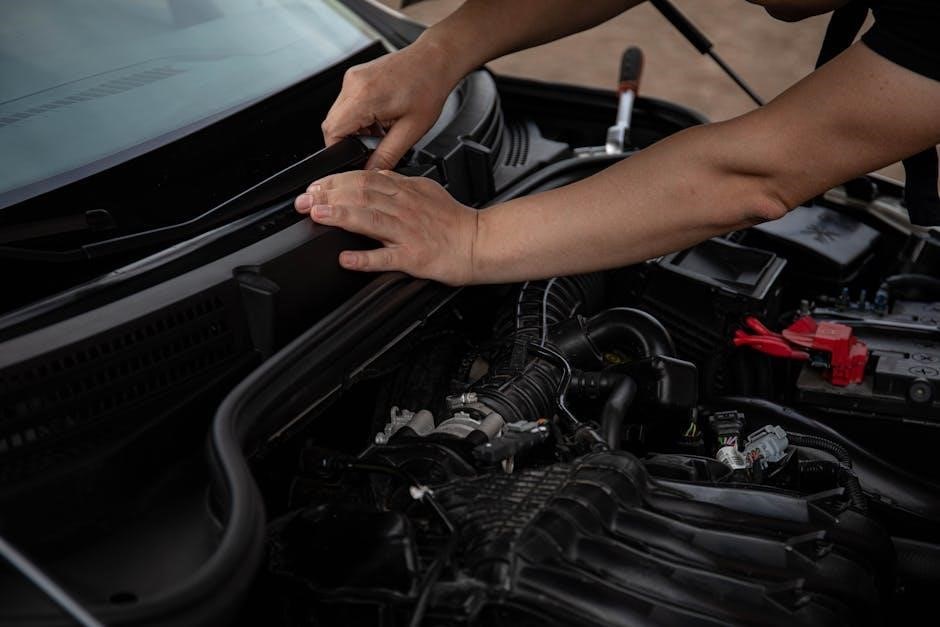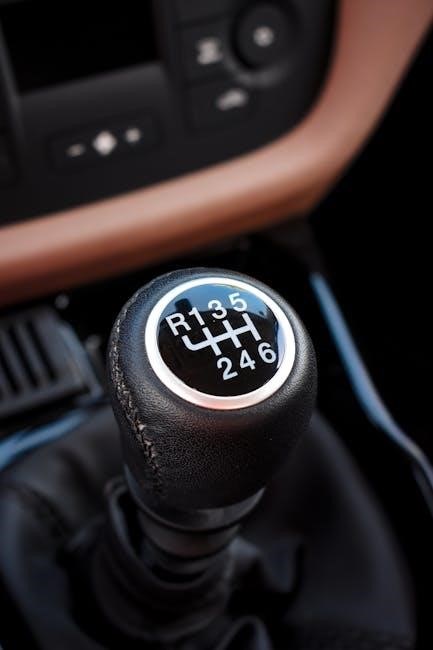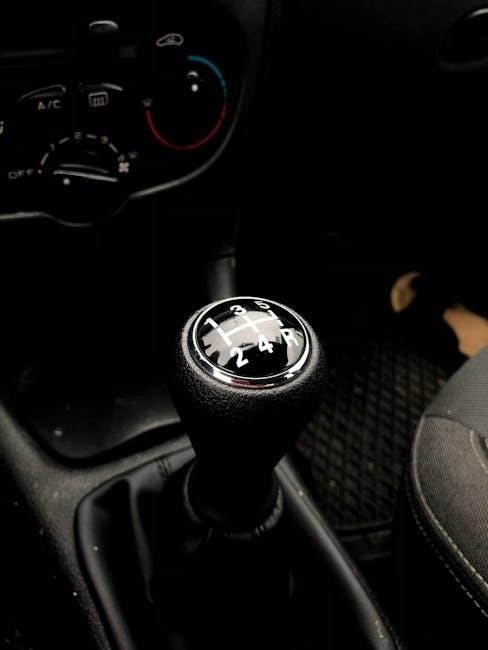G56 Manual Transmission Overview
The G56 is a 6-speed manual transmission designed for light and medium-duty diesel trucks, known for its durability and smooth shifting. Manufactured by Mercedes-Benz, it offers excellent performance and control in heavy-duty applications, making it a popular choice for Dodge Ram trucks from 2005 to 2018. The G56 replaced the NV5600, providing improved reliability and driver experience in demanding conditions.
1.1 History and Development
The G56 6-speed manual transmission was introduced by Ram in 2005, replacing the heavier NV5600. Designed by Getrag and supplied by Mercedes-Benz, it was built for light and medium-duty trucks. The G56 offered a smoother, quieter operation with a dual mass flywheel, enhancing driver comfort. Produced until 2018, it became a staple in Dodge Ram trucks, marking the end of manual transmissions in full-size pickups after its discontinuation.
1.2 Key Features and Design
The G56 manual transmission is a 6-speed, fully synchronized gearbox designed for durability and smooth operation. Featuring a dual mass flywheel, it reduces vibration and enhances shifting quality. Built with high-strength materials, the G56 is lightweight yet robust, ensuring reliability in heavy-duty applications. Its longitudinal design and optimized gear ratios make it ideal for towing and hauling, while the compact aluminum case contributes to overall efficiency and performance in diesel truck setups.
Technical Specifications
The G56 is a 6-speed manual transmission designed for 2005-2018 Dodge Ram trucks, offering durability and lightweight construction. It features a dual mass flywheel for smooth shifting and is built for heavy-duty applications, ensuring reliability in demanding conditions.
2.1 Gear Ratios and Synchronization
The G56 transmission features six forward gears and one reverse gear, with optimized ratios for both on-road and off-road performance. It incorporates a dual mass flywheel for smoother shifting and is fully synchronized, ensuring precise and durable gear engagement. The gear ratios are designed to handle heavy-duty applications, providing excellent torque management and control during towing and hauling. This setup enhances both performance and driver experience in demanding conditions.
2.2 Lubrication and Maintenance Requirements
The G56 transmission requires synthetic oil for optimal performance and longevity. Regular fluid changes, typically every 30,000 to 60,000 miles, are essential to maintain smooth operation. The transmission filter should be replaced during servicing to prevent contamination. Inspecting the drain plug and gasket for wear is recommended. Proper lubrication and timely maintenance ensure minimal wear on gears and synchronizers, preserving the transmission’s reliability and performance in heavy-duty applications.

Applications and Compatibility
The G56 manual transmission is primarily used in Dodge Ram 2500 and 3500 trucks from 2005 to 2018. It is compatible with 5.9L and 6.7L Cummins engines.
3.1 Vehicle Models Equipped with G56 Transmission
The G56 manual transmission is exclusively fitted to Dodge Ram 2500, 3500, 4500, and 5500 trucks from 2005 to 2018; It is compatible with 5.9L and 6.7L Cummins diesel engines, making it a standard or optional feature in these models. The G56 was particularly popular in Ram HD pickups and chassis cab configurations, offering a robust solution for heavy-duty applications. It was also available in select special edition Ram trucks during its production run.
3.2 Special Editions and Unique Applications
The G56 transmission was occasionally featured in special edition Ram trucks, such as performance or off-road packages, enhancing its appeal. It was also used in chassis cab configurations for commercial applications, showcasing its versatility. Enthusiasts often sought the G56 for its durability in unique setups, like heavy-duty towing rigs or custom builds. Its availability in select limited-edition models further cemented its reputation as a reliable and versatile transmission option.

Performance and Capabilities
The G56 transmission excels in heavy-duty applications, offering exceptional towing and hauling capabilities. Its smooth shifting and robust design provide precise control and stability, making it ideal for demanding tasks.
4.1 Towing and Hauling Capacity
The G56 manual transmission is renowned for its exceptional towing and hauling capabilities, making it ideal for heavy-duty applications. Designed to handle substantial loads, it pairs seamlessly with the Cummins diesel engine, delivering consistent power and control. Its robust construction ensures stability under strain, while precise gear engagement enhances towing performance. This transmission is a favorite among drivers needing reliable heavy-duty capabilities for large trailers and payloads.
4.2 Shift Quality and Driver Experience
The G56 manual transmission is celebrated for its smooth, precise shifting and responsive driver feedback. Its dual mass flywheel design minimizes vibrations, offering a refined driving experience. The fully synchronized gears provide crisp engagement, while the ergonomic shifter enhances control; This transmission excels in both daily driving and heavy-duty tasks, delivering a balance of comfort and performance that appeals to both enthusiasts and professionals. Its reputation for reliability further enhances the overall driving satisfaction.

Common Problems and Solutions
The G56 transmission is reliable but may experience issues like synchronizer wear and bearing noise. Regular maintenance and timely repairs can prevent major failures, ensuring longevity and performance.
5.1 Known Issues and Failure Points
The G56 transmission is generally reliable but can experience issues like synchronizer wear, leading to difficulty shifting into higher gears. Bearing noise may develop due to insufficient lubrication or high mileage. Input shaft seal leaks and clutch failure are also common, particularly under heavy loads. Regular maintenance, including fluid checks and clutch inspections, can help mitigate these issues and extend the transmission’s lifespan.
5.2 Repair and Troubleshooting Tips
Common G56 issues include synchronizer wear and bearing noise. Inspect and replace worn synchronizer rings or bearings. Address input shaft seal leaks promptly to prevent fluid loss. For clutch failure, install a heavy-duty clutch kit. Regular lubrication checks and fluid changes are crucial. Refer to the service manual for torque specs during repairs. DIY enthusiasts can replace seals and bearings, but complex issues may require professional assistance.
Maintenance and Service
Regular lubrication checks and fluid changes are essential for G56 longevity. Inspect the clutch for wear and replace as needed. Monitor for input shaft seal leaks and address promptly to prevent damage. Adhere to recommended service intervals for optimal performance and durability.
6.1 Service Intervals and Recommendations
Regular maintenance is crucial for the G56 transmission’s longevity. The manufacturer recommends changing the transmission fluid every 30,000 to 60,000 miles, depending on usage. Replace the filter during each fluid change to ensure optimal performance. Inspect the clutch and input shaft seal for wear or leaks annually. Lubricate the shift linkage and clutch pedal every 15,000 miles. Adhere to these intervals to prevent premature wear and ensure smooth operation.
6.2 DIY Maintenance Tips
Performing regular DIY maintenance on the G56 transmission can enhance its longevity. Change the transmission fluid every 30,000 to 60,000 miles using a high-quality synthetic fluid. Replace the filter during each fluid change to prevent contamination. Inspect the clutch pedal and linkage for wear, and lubricate them every 15,000 miles. Check for leaks around the input and output shafts annually. These simple steps can prevent major repairs and ensure smooth shifting.
Upgrades and Modifications
Performance upgrades for the G56 include gear ratio optimizations and aftermarket components to enhance towing capacity and durability, making it ideal for heavy-duty applications and enthusiast modifications.
7.1 Performance Upgrades for G56 Transmission
Performance upgrades for the G56 transmission include high-performance gear sets, upgraded bearings, and enhanced clutch systems to improve durability and torque capacity. Aftermarket components like short-throw shifters and heavy-duty flywheels can enhance shifting precision and heat resistance. These upgrades are particularly beneficial for heavy-duty towing and high-performance applications, ensuring the transmission withstands increased stress while maintaining smooth operation.
7.2 Aftermarket Parts and Accessories
The G56 transmission supports a wide range of aftermarket parts, including rebuild kits, bearings, syncro components, and gears. Performance clutch kits and heavy-duty flywheels are popular upgrades for enhanced durability. Suppliers offer individual components like shafts and cases, as well as complete rebuilt transmissions. These parts are designed to improve performance, extend lifespan, and maintain compatibility with Dodge Ram applications, ensuring optimal functionality in demanding conditions.
Comparison with Other Transmissions
The G56 transmission is lighter and shifts smoother than the NV5600, offering better driver control. It also provides superior towing capability compared to modern automatic transmissions.
8.1 G56 vs. NV5600 Transmission
The G56 transmission is lighter and more refined than the NV5600, offering smoother shifts and better low-speed maneuverability. It features a dual mass flywheel for reduced vibrations, while the NV5600 is heavier and more rugged. The G56 provides improved towing and hauling capabilities, making it ideal for heavy-duty applications. Both transmissions are reliable, but the G56’s modern design and optimized gear ratios give it an edge in performance and driver comfort.
8.2 G56 vs. Modern Automatic Transmissions
The G56 manual transmission offers superior driver control and engagement compared to modern automatics, but lacks the convenience and seamless shifting of automatics. While automatics excel in traffic and ease of use, the G56’s tactile feedback and precise gear control are favored by enthusiasts. Modern automatics often boast better fuel efficiency and advanced features, yet the G56 remains a preferred choice for heavy-duty towing and hauling, where manual control is advantageous.

Parts and Accessories
The G56 transmission offers a range of parts and accessories, including rebuild kits, bearings, gears, and syncro components. Performance clutch kits and aftermarket upgrades are also available.
9.1 Rebuild Kits and Components
The G56 transmission offers comprehensive rebuild kits, including bearings, gears, shafts, and syncro components. These kits are designed for restoration or performance upgrades, ensuring optimal functionality. Individual parts like bearings and syncro rings are also available, catering to specific repair needs. High-quality components ensure durability and smooth operation, making them ideal for heavy-duty applications and towing demands.
9.2 Clutch and Flywheel Options
The G56 transmission is paired with a dual mass flywheel for smooth shifting and reduced vibration. Clutch kits are available in various configurations, including organic and ceramic options, to suit different driving demands. High-performance clutches are designed for heavy-duty towing and hauling, while stock replacements maintain factory-like performance. These components ensure reliable engagement and disengagement, enhancing the overall driving experience in Dodge Ram trucks equipped with the G56 manual transmission.

Installation and Swapping
The G56 transmission, known for its durability, is installed in Dodge Ram trucks from 2005 to 2018, offering a smooth shifting experience during its swapping process.
10.1 G56 Transmission Swap Guide
The G56 transmission swap is a complex process requiring mechanical expertise and specialized tools. It is compatible with 2005-2018 Dodge Ram 2500-3500 trucks, especially those equipped with Cummins engines. The swap involves removing the old transmission, installing the G56, and reconnecting components like the clutch, driveshaft, and linkages; Ensure proper alignment and torque specifications for a smooth, reliable installation. Consult a detailed service manual for precise instructions and safety guidelines.
10.2 Compatibility and Installation Tips
Ensure the G56 transmission is compatible with your vehicle’s make, model, and engine. Verify the gear ratio and drivetrain configuration before installation. Use a dual mass flywheel for smooth operation and avoid clutch compatibility issues. Properly align the transmission with the engine and drivetrain. Tighten all bolts and connections to specified torque values. Consult a professional if unsure to prevent damage and ensure optimal performance. Plan for adequate time and tools for a successful swap.

Community and Support
The G56 transmission has an active community with dedicated forums and online resources. Enthusiasts and experts share knowledge, troubleshooting tips, and modification ideas. Specialist repair shops offer tailored support and services.
11.1 Forums and Online Resources

The G56 transmission has a strong online presence with dedicated forums and communities. Enthusiasts and experts share insights, troubleshooting tips, and modification ideas. Popular forums discuss maintenance, performance upgrades, and common issues. Specialist repair shops like Pine Grove Transmission offer expertise and resources. Online platforms also provide access to service manuals, parts lists, and DIY guides, fostering a supportive environment for G56 owners and enthusiasts.
11.2 Specialist Repair Shops
Specialist repair shops like Pine Grove Transmission offer expert service for G56 manual transmissions. With over 30 years of experience, these shops provide detailed diagnostics, rebuilds, and custom upgrades. They cater to enthusiasts and heavy-duty users, addressing common issues like worn bearings or synchro rings. Their expertise ensures optimal performance and longevity, making them invaluable for maintaining the G56’s reputation as a reliable and durable transmission.
Legacy and Future Prospects
The G56 manual transmission holds a significant place in automotive history, particularly for Dodge Ram trucks. Its discontinuation in 2019 marked the end of an era for manual transmissions in North American pickups. Despite this, the G56 remains a favorite among enthusiasts for its durability and performance. While modern trucks favor automatics, the G56’s legacy lives on in the used market and among custom builds, ensuring its reputation as a reliable workhorse for years to come.